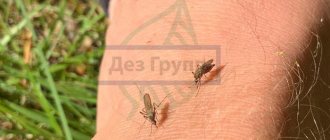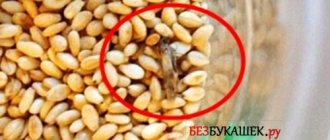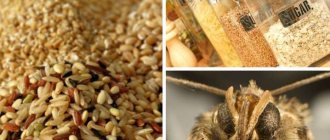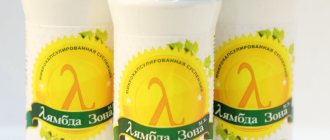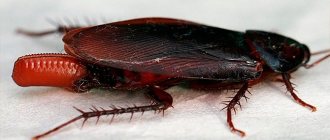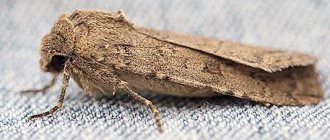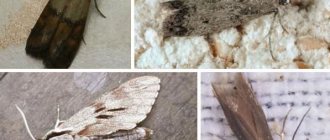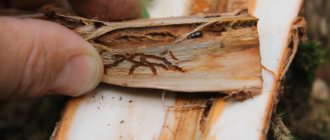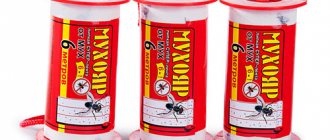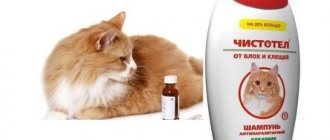Varieties of moths
We usually divide the moths that live in the apartment into food moths and clothing moths, but they have a little more varieties.
Moth happens:
Woolen (fur coat) - claims to be the most valuable thing in the house. A gray with black speckled butterfly that feeds on fur, wool, as well as down pillows and books.
Furniture – golden. He sleeps on the sofas with us, eats furniture fabric, but doesn’t disdain fur coats either.
Clothes - has a yellow color with a purple tint. Unlike the fur coat, she is not picky about clothes.
Carpet - gray-brown, with patterned wings. In addition to carpets, it eats leather and fur products.
Book - brown-golden. Loves all types of print media.
Grain is also food. Brown with stripes on gray wings. Eats cereals and tea.
Fruity – white-yellow with brown speckles. Specializes in dried fruits.
In addition, cabbage, rye and apple trees have their own pests, but in this article we are talking about the inhabitants of the house.
Description and characteristics of the insect
A moth is a small lepidopteran insect. There are more than 2,000 species that are distributed throughout the world. A small part lives in human homes, the rest live in the wild. Insects are active in the evening and at night; during the day they sit out in secluded, darkened places, as they do not tolerate sunlight well.
Appearance
Adults do not eat; the nutrients accumulated at the larval stage are enough for them to survive. But moth caterpillars are voracious. They are the ones who cause the main damage to products, things or plants.
Appearance of a moth
Despite the large number of moth species, they are not very different from each other in appearance. A moth looks like a small moth with narrow wings. Body dimensions from 5 to 1.2 mm, wingspan from 10 to 20 mm. The color is inconspicuous, depends on the habitat, most often fluctuates between shades of gray and brown. The wings of most species have a pearlescent tint. Moth larvae are white, body size 1 – 1.5 mm, head dark.
How long does a moth live?
The lifespan of a moth is largely determined by the species, living conditions, in particular, climate and weather conditions, temperature, humidity, and for the larvae, also the availability of a sufficient amount of food. The average lifespan of a moth is from 1 to 4 weeks. The larvae live longer - from 2 to 8 months.
Where does he live?
The habitat of the moth depends on the type of insect. Most of them live on the plants that they feed on, some settle in houses, apartments, warehouses, barns and sheds, causing damage to fabrics, furs, and products; there are moths that live in bird nests or animal burrows.
Where do moths come from in an apartment?
Unfortunately, this insect can be found even in the cleanest home. The main thing is to have something to profit from. And it doesn’t come here out of nowhere.
Food moths most often enter homes along with cereals, dried fruits and animal feed. This is a “bonus” to the purchase, especially if the price is pleasantly reduced by the store. The butterfly really loves unsealed packaging, so if you store cereals in an open bag, fabric bags, cardboard and sort it out quite rarely, it will occupy all the supplies.
The insect can migrate from neighbors through a ventilation pipe or even fly into a window. However, this does not happen very often, since his ability to fly is limited.
Non-food species can “move” along with clothing, upholstered furniture or carpet. Keep this in mind, especially if you are going to buy things second-hand.
Chemicals that kill moths
You can remove moths from your home with the following medications:
- "Dezmol";
- "Supromit";
- "Antimol";
- "Armol";
- "Raid of the Andes";
- "Molemore";
- "Suprozol";
- "Moskitol";
- "Trap";
- "Raid antimoth" and others.
These anti-moth preparations either do not smell at all or have a pleasant aroma. Before use, be sure to read the instructions. You will understand when the room can be ventilated after using the product.
After opening the can, you can use the anti-moth preparation for six months. The products most often smell like lemon or lilac, chamomile or tangerine. Lavender scent is also popular.
Aerosols are easy to use and smell nice. The active ingredient in most formulations is permethrin, which is toxic to moths. The butterfly inhales the drug and dies, and the product also destroys eggs and larvae. The aerosol should be applied to the shelves where children's and your things are stored.
We invite you to take a closer look at some effective chemicals that destroy moths.
"Armol"
This is a preventative agent that destroys both moths and skin beetles. You can sprinkle it on fur or clothing made of any material. There will be no stains from the product.
An open remedy is valid for six months. Smells like lavender.
Armol Expert is also selling well. The composition is the same, but the liquid does not smell anything. This drug is used when processing things that are stored in a warehouse or exhibited at an exhibition. For a 165 ml can you will pay approximately 65 rubles.
"Raptor"
The product smells a little like lemon. Apply it to walls or shelves, it protects clothes for up to 1 year. If a moth inhales the chemical, it will soon die. A 175 ml bottle costs 90 rubles.
Interesting Facts
Contrary to popular belief, not only household pests are called moths, but also a couple of thousand species of moths from the order Lepidoptera.
The famous silkworm is also a moth, domesticated and put at the service of man.
Like many pests, house moths are widespread on the planet. But she is very uncomfortable in the tropics.
Only larvae eat clothes and food. Adult butterflies do not have a mouthpart: they receive their entire supply of nutrients “in childhood.”
Appearance
What does 1 common mole look like? This moth has a yellow color - gray or dark. A red tint is sometimes visible on the body of this insect.
Such a parasite has 2 pairs of shiny wings that shimmer in the sun. A fringe is visible along its edges. The span of the front wings of such a moth is 9–18.5 mm. The hind wings are more uniform in color and smaller in size.
The chest of such a small pest is brown on top and light yellow and shiny below.
The male of this insect is smaller than the female, and after mating with the female and fertilizing her, he quickly dies. The female of this small pest lives for about 1 month.
How to fight moths
If rags and slippers could destroy this insect, it would have died out long ago. Alas, with pops we kill mostly flying males, and females hide in folds of clothing or bags of food and lay eggs.
All pest control products are divided into those that kill insects and prevent their spread. Let's take a closer look.
Chemicals
These include aerosol cans, fumigators with insecticides and tablets - the choice of how to poison the hated butterfly is quite wide.
Aerosols are sprayed into wardrobes and applied to clothing, furniture and carpets. After treatment, the room is closed for several hours, and then the dead insects are removed. The degree of toxicity of each product is different - some drugs are not recommended for use in families with children. It is worth noting that not all brands are effective against larvae.
Fumigators are available in two types: with plates and bottles. They are intended for long-term (several days) use. The drug destroys only adult moths, so sessions need to be repeated periodically. Manufacturers claim that the substances in its composition are harmless to humans and animals.
Tablets and balls do not kill either the butterfly or the offspring. They are intended only to repel moths. Pros: easy to use (you just need to place 2-3 pieces on a shelf) and last up to 6 months. The downside of mothballs is their toxicity.
Chemical products also include impregnated cardboards . Their active ingredients are different, the smell can be strong or moderate. The aroma does not kill, but only repels insects.
Mechanical means
Traps in the form of a feeder are placed in closets with clothes and food. They lure the moths with a pleasant smell and glue them tightly. It is advisable to set the trap for two months so that the undetected larva turns into a butterfly and flies into the jar.
Repellent sections with an unpleasant odor for insects are hung on the window and do not allow adult insects into the house.
Sticky traps like fly tape are designed to kill flying insects. Non-toxic, but only affects butterflies and is powerless against larvae.
Folk remedies
Unlike industrial ones, folk remedies are cheaper, are more often at hand and are almost always safe for humans. But they only have a preventive effect.
Help against clothes moths:
- dry lavender or its essential oil;
- dried tansy flowers (place in cloth or gauze to prevent them from falling off);
- twigs of wormwood (the smell disrupts the insect’s orientation in space, and it loses its ability to reproduce);
- fresh newspapers placed on a shelf with clothes or in shoes.
It is important not to overdo the amount of herbs, otherwise the smell in the room will be heavy.
Among the folk remedies there are also fragrant and ordinary tobacco: the first is grown on the windowsill, and the second, in crushed dry form, is laid out on shelves. But I wouldn’t use this option – it’s still harmful.
The following tools will be useful in the kitchen:
- fresh mint sprigs laid out on the shelves;
- lavender or essential oil;
- treating cabinets with vinegar;
- a clove of garlic in a cereal container;
- bay leaves (you can grow cherry laurel right in your apartment);
- cloves, rosemary or essential oils.
Also on our blog you will find detailed instructions on how to get rid of bugs in cereals.
Heat treatment
Exposure to high (from +45 degrees) or low (below –5) temperatures instantly kills adults and their larvae. Upholstered furniture is treated with a steam cleaner, carpets and fur coats are taken out into the cold.
Reproduction and life stages
If a person knows how moths reproduce, then he carries out the necessary prevention and fights it more effectively.
How do house or other moths reproduce? First of all, you need to keep in mind that 5-6 hours after mating, the female immediately lays 50-100 eggs.
The optimal temperature for the development of 1 or several eggs is 30–33 degrees Celsius. At temperatures below 30 but above 15 degrees Celsius, the duration of egg maturation increases to 35 days.
Such a lepidopteran pest goes through the following 2 stages of development:
- larva. Under favorable conditions, larvae are born after a few days. These caterpillars are off-white in color. They develop in about 14 days and slowly increase in size to 1 cm;
- formation of a cocoon and an adult.
At the last stage of development, such a lepidopteran insect is covered with a cocoon. Such a pupa remains motionless for about 3 days.
Then a moth is born, ready to mate, and at this time its accelerated moth reproduction begins.
Preventing moths
Despite the guarantees of pest control companies, it is problematic to remove the insect forever. But to avoid her re-occupying the apartment, it is worth observing the following preventive measures:
- Store cereals and other products in closed glass or metal containers.
- It is advisable to bake each cereal in the oven after purchase.
- Clean cabinets regularly, ventilate them and expose them to sunlight. The sun can be replaced with an ultraviolet lamp.
- Go through your wardrobe as often as possible. At the end of the season, clean and wash items, and only then put them away for storage. It is good to store clothes in plastic covers.
- The carpet should be vacuumed at least once a week, shaken out in the sun or in the cold.
- Use folk remedies that repel moths.
Agricultural pests
Some types of moths cause serious damage to agricultural crops. Cereals are especially affected: wheat, rye, corn, oats, barley. Even a small colony of pests, multiplying quickly, can destroy a significant part of the crop.
grain moth
The grain moth is a yellowish-gray moth with a bronze tint, with a wingspan of 11 to 17 mm. Lays eggs on grains. The hatched larva gnaws through the grain shell, penetrates inside, where it grows, feeding on the inside of the grain. By the time of pupation, the grain is already hollow. This species can damage both grain crops growing in the field (most often in regions with warm climates) and grain harvested for storage.
Cereal
Rye moth
The rye moth looks like a small yellow-brown butterfly. Lays eggs on winter seedlings and wild cereals. The larvae live in the stems, gnawing out their core. Prefers the more tender part located under the ear. Due to the damaged stem, the ears gradually dry out.
